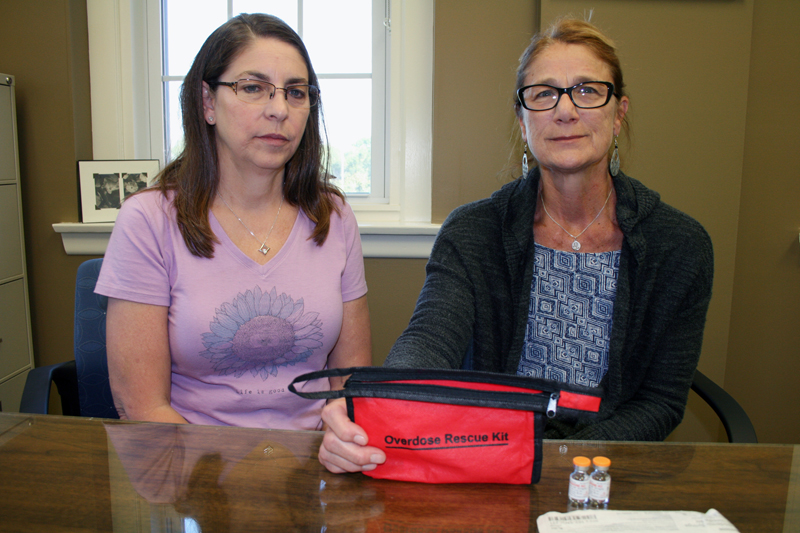By Barb Arland-Fye
The Catholic Messenger
More than 10,000 people died from using heroin in 2014 in the United States, an epidemic that claimed the life of Benjamin Van Camp that year. The 27-year-old, who spent his early childhood in Davenport, died three years after Andy Lamp, also a Davenport native and one of 4,397 people who died of a heroin overdose in 2011, at age 33. Their paths never crossed, but the two men left behind grieving mothers committed to reducing heroin overdose deaths.

Sue Van Camp, left, and Kim Brown, both of Davenport, each lost an adult son to a heroin overdose. The women belong to Quad Cities Harm Reduction, which successfully lobbied for passage of an Iowa law that expands the use of a medication which reverses heroin and prescription opiate overdoses. They show one of the kits and the medication, naloxone, also known as Narcan.
Govtrack.us reports that overdoses of heroin, prescription drugs and opioid pain relievers surpassed car accidents as the leading cause of injury-related death in America in 2014. These deaths reached their highest levels of the 21st century in 2014, and heroin overdoses have more than tripled in the last five years, the website stated. New legislation, which received bipartisan support, was passed this year to tackle the epidemic.
Heroin’s impact
“The current drug problem in our society is not a ‘back alley’ problem; it is a very real epidemic in our communities across the United States and affects the lives of ‘normal’ people,” says Sue Van Camp, Ben’s mother. She shared her family’s story in the Opiate and Heroin Awareness Toolkit booklet for Washington County, Wis. Married for 34 years and mother of four children, she said, “My husband and I both come from large families and live by our Catholic faith. We are all close to our extended family, talking and visiting often. To most people, we look like a ‘normal’ family. ‘Drugs’ would not happen in our family.”
Ben began smoking marijuana about 10 years before his death and within a couple of years began taking narcotic pills. Later, after sustaining a hand injury at work, he became addicted to pain pills. He tried heroin to ease the pain, his mother said. “Needless to say, it was the worst decision of his life.” She noted that Ben tried repeatedly to overcome his addiction. “Heroin took his life on March 27, 2014,” said Sue, who moved her family back to Davenport after Ben’s death. “It can happen to you, your neighbor, your child, your parent. It knows no boundaries by age, race or income.”
Kim Brown, a registered nurse who lives in Davenport, said her son Andy Lamp was an extremely bright child who pursued his post-secondary education at Hamilton Technical College in Davenport. He was working and attending school when he began using heroin, which ended those other pursuits. “Andy didn’t just use heroin. When he died, he had cocaine in his system,” said his mother, who is now raising her son’s two children.
“I’ve been a police officer for 12 years. I’ve never seen heroin use as rampant as it is today, which is really unfortunate,” said Detective Josh Paul of the Bettendorf Police Department. He tells of finding a 20-year-old, dead of a heroin overdose on a couch in the young man’s home. “I don’t have kids myself, but I deal with kids’ parents. It’s really tough breaking the news that their kid is dead or in the hospital because of a drug overdose. When you see someone who is 20 years old and is dead and their life is over, it’s not easy to deal with.”
The detective, who works in his department’s drug unit, thinks heroin use is up for a couple of different reasons. Marijuana use is at an all time high with high school and college-age kids, and it is more potent than years ago. He thinks kids eventually want a bigger high and begin experimenting with other drugs. Another contributing factor is the wide-spread prescribing and use of addictive painkillers, which can lead to re-sale on the streets. Heroin is cheaper than prescription pain killers, but the heroin has been altered nearly a dozen times before it reaches the user, Detective Paul said. A dose can cost around $15 or $20, but the cost grows as the user builds up tolerance to heroin.
Raise awareness and preventative measures
Both mothers and the Bettendorf detective stress the importance of promoting awareness of addictive illness, a disease that needs to be treated and whose victims should not be shunned or shamed. “Society shuns and stigmatizes these guys. As mothers, we try to love them through it,” said Kim, who founded Quad Cities Harm Reduction after her son Andy’s death. She didn’t want anyone else to suffer the preventable death of a loved one. Sue was ready to join that effort when she returned to Davenport.
The two moms, along with other members of Quad Cities Harm Reduction, successfully lobbied for passage of an Iowa law this year that expands the use of a medication which reverses heroin and prescription opiate overdoses. Family members and other care givers of high-risk opiate users can get Naloxone, also known as Narcan, with a prescription. Law enforcement officers, firefighters and EMTs are now allowed to administer the drug, along with paramedics.
While the drug won’t alleviate the causes of the national heroin epidemic, it can keep people alive so that they have the chance to try to turn their lives around, the mothers say. “We do not approve of drug use, but we certainly don’t want people to die,” said Kim. “I would rather have my son alive now – even if he chose not be abstinent (from heroin use).” She said Quad Cities Harm Reduction members are eager to go out in the community to educate people about harm reduction and what steps they can take. She can also teach people how to administer Naloxone to someone who has overdosed on heroin.
National efforts to address epidemic
The overdose epidemic is capturing headlines and is being talked about on news programs and in state and federal government chambers. In a proclamation for Prescription Opioid and Heroin Epidemic Awareness Week (Sept. 16-23), President Obama noted that the number of overdose deaths involving opioids has nearly quadrupled since 1999. Opioid refers to a family of opiates that includes heroin and pain relievers such as Oxycodone and Hydrocodone.
“Opioid use disorder, or addiction to prescription opioids or heroin, is a disease that touches too many of our communities – big and small, urban and rural,” the president said. It “devastates families, all while straining the capacity of law enforcement and the health care system.”
He called on Congress to provide $1.1 billion to expand access to treatment services for opioid use disorder. The investment would help build on overdose prevention strategies, such as increasing access to Naloxone and improving opioid prescribing practices.
A few weeks earlier, the U.S. Department of Health and Human Services (HHS) announced $53 million in funding to 44 states, four tribes and the District of Columbia for addressing opioid use disorders. Iowa is among 21 states and four tribes to receive some of that funding in the Fiscal Year 2016 budget to strengthen drug misuse prevention efforts. But, HHS says more funding is needed. President Obama’s Fiscal Year 2017 budget proposal calls for states to be eligible for up to $920 million over two years to expand access to treatment. Congress has not funded that budget proposal.
Kent Ferris, director of the Diocese of Davenport’s Social Action Office and Catholic Charities, knows about drug addiction because he’s mentored men enrolled in drug court. It’s a subject the faith community should care about, he says. “Realize that addiction is a disease. As such, we’ve got to support friends and family struggling with addiction … support 12-step programs. If there’s a need for a group to have a place to meet, talk with your parish pastoral council about extending an invitation to the 12-step community.”
(If you’d like to know more about Quad Cities Harm Reduction, visit the website ODAWalk.com or call Kim at (563) 349-2434 for more information.)
(Coming next week: addressing the epidemic.)
Naloxone facts
Naloxone, also known as Narcan, is a prescription medication that reverses heroin and prescription opiate overdoses. It has been called the opiate antidote.
Naloxone blocks the effects of heroin and opiates on the brain, thus reversing overdoses. During an overdose, people stop breathing. Naloxone helps restore breathing and saves lives.
It is as nontoxic as water and has no potential for addiction. It would have no effects on a person who has not used heroin or other opiates.
From 2010-2014, the number of organizations that distribute Naloxone has more than doubled. In the same timeframe, the number of laypeople provided training and Naloxone kits increased by 187 percent and reported reversals increased by 160 percent, from 10,000 reversals between 1996-2010 to 26,000 reversals in total between 1996 and 2014.
Source: Iowa Senate File 410, Quad Cities Harm Reduction ODAWalk.com











